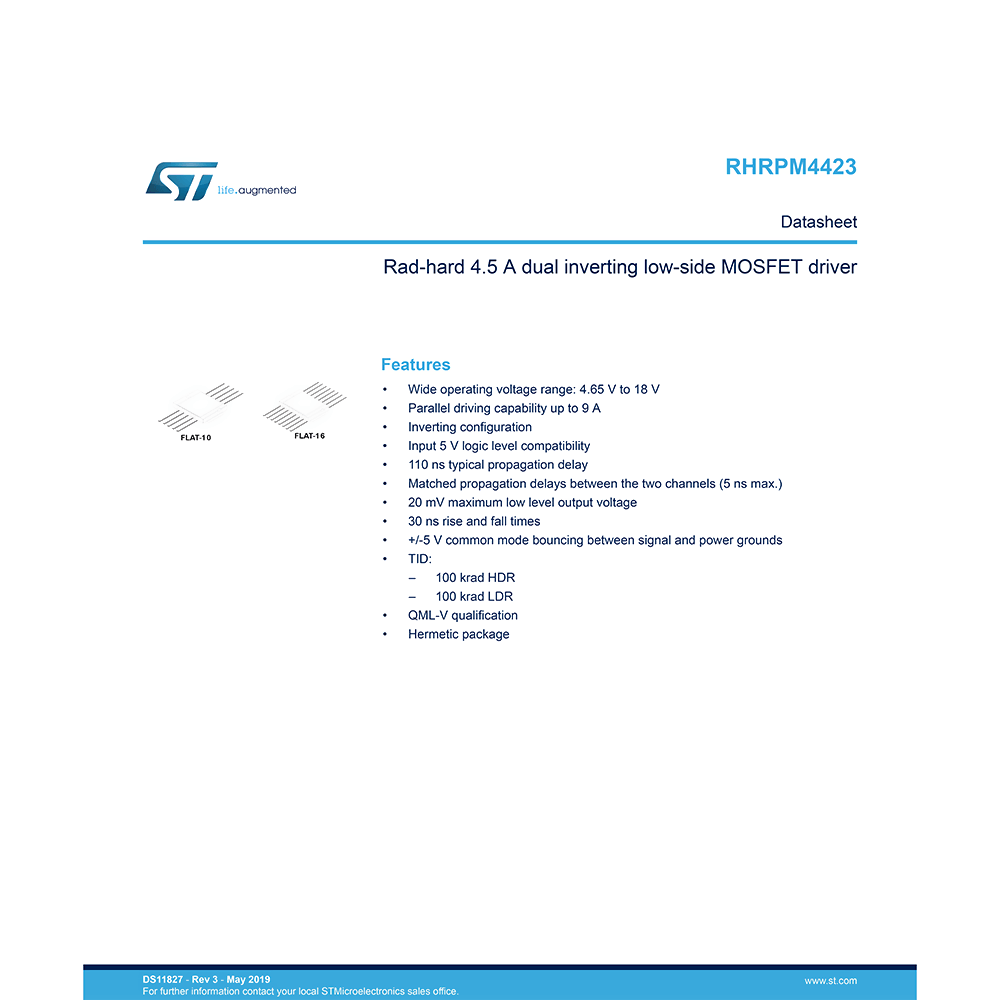RHRPM4423 ST 4.5A Dual Inverting Low-Side MOSFET Driver Data Sheet
Download PDF datasheet for ST RHRPM4423 Rad-hard 4.5A Dual Inverting Low-Side MOSFET Driver (EN) 31 pages DS11827 Rev.3 2019 zip
Description
This PDF data sheet is for the ST RHRPM4423 Rad-hard 4.5A Dual Inverting Low-Side MOSFET Driver.
About the Item
ST RHRPM4423 Rad-hard 4.5A Dual Inverting Low-Side MOSFET Driver
The RHRPM4423 is a flexible, high-frequency dual low-side driver specifically designed to work with high capacitive MOSFETs and IGBTs in an environment with high levels of radiation such as aerospace.
The RHRPM4423 outputs can sink and source 4.5 A of peak current independently. If two PWM outputs are in parallel, a higher driving current (up to 9 A peak) can be achieved.
The RHRPM4423 works with CMOS/TTL compatible PWM signal so it can be driven by an external PWM controller, such as the ST1843 or the ST1845.
The FLAT-16 version conforms to an industry standard pinout and can dissipate up to 550 mW per channel, while FLAT-10 version optimizes the PCB real estate. Since both of packages are hermetic, this device is suitable for any kind of harsh-environment.
(PDF) DATASHEET (ENGLISH)
SUMMARY OF CONTENTS
1 Block diagram
2 Pin configuration
3 Typical application diagrams
4 Maximum ratings
5 Electrical characteristics
6 Radiations
6.1 Total ionizing dose (MIL-STD-883 test method 1019)
6.2 Heavy Ions
7 Device description
7.1 Overview
7.2 Input stage
7.3 Output stage
7.4 Parallel output operation
7.5 Gate driver voltage flexibility
8 Design guidelines
8.1 Output series resistance
8.2 Power dissipation
9 Layout and application guidelines
10 Typical performance characteristics
11 Package information
11.1 FLAT-16 package information
11.2 FLAT-10 package information
12 Ordering information
12.1 Other information
12.1.1 Data code
12.1.2 Documentation
– Revision history
– Contents
LIST OF TABLES
Table 1. Pin description
Table 2. Thermal data
Table 3. Absolute maximum ratings
Table 4. Electrical characteristics
Table 5. TID
Table 6. HI
Table 7. Flat-16 package mechanical data
Table 8. Flat-10 package mechanical data
Table 9. Order code
Table 10. Documentation provided
Table 11. Document revision history
LIST OF FIGURES
Figure 1. Block diagram
Figure 2. Pin configuration (top view)
Figure 3. Typical application diagram
Figure 4. Typical application diagram as buck switching regulator
Figure 5. Time diagram
Figure 6. Parallel output connection
Figure 7. Minimum gate resistance
Figure 8. Driver and load equivalent circuits
Figure 9. Power dissipation with Rg = 2.2 Ohms
Figure 10. Power dissipation with Rg = 4.7 Ohms
Figure 11. Output current vs. time
Figure 12. Evaluation board layout: top view
Figure 13. Evaluation board layout: bottom view
Figure 14. PWM_x rise time vs supply voltage
Figure 15. PWM_x rise time vs supply voltage
Figure 16. PWM_x fall time vs supply voltage
Figure 17. PWM_x fall time vs temperature
Figure 18. Input-to-output delay time vs supply voltage
Figure 19. Input-to-output delay time vs temperature
Figure 20. Source resistance vs temperature
Figure 21. Sink resistance vs temperature
Figure 22. Output resistance vs current
Figure 23. Operating supply current vs supply voltage (operating frequency = 100 kHz)
Figure 24. Operating supply current vs supply voltage (operating frequency = 300 kHz)
Figure 25. Operating supply current vs supply voltage (operating frequency = 500 kHz)
Figure 26. Quiescent current vs temperature
Figure 27. Flat-16 package outline
Figure 28. Flat-10 package outline
Figure 29. Date code composition
Why download the Datasheet?
This datasheet provides all the information from ST about the RHRPM4423 MOSFET Driver, as detailed in the table of contents. Reading it completely will address most questions you might have. You can download and save it for offline use, including viewing it on your device or printing it for your convenience if you prefer a paper version.
How to download the Manual?
Download it by clicking the button below
Helped you out?
Glad to hear that. It would be awesome if you could . . .


